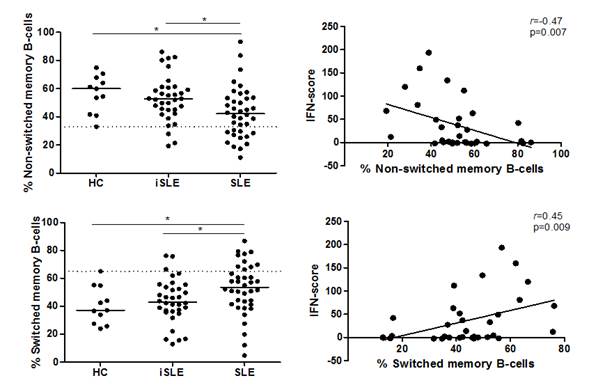Session Information
Date: Monday, October 22, 2018
Title: Systemic Lupus Erythematosus – Etiology and Pathogenesis Poster II
Session Type: ACR Poster Session B
Session Time: 9:00AM-11:00AM
Background/Purpose:
Incomplete systemic lupus erythematosus (iSLE) includes patients with typical features of SLE, who do not meet classification criteria. Still, up to 50% will develop SLE in the future. Follow-up of these iSLE patients can potentially unravel the pathogenesis of SLE. Interferon (IFN) type-I is an important early mediator in SLE. Furthermore, B cells are considered to be the main culprits in SLE pathogenesis, owing to their production of autoantibodies. The purpose of this research is assessing whether IFN gene upregulation is associated with alteration in B-cell subset distribution in iSLE patients.
Methods:
Thirty-four iSLE patients (ANA titer ≥1:80, ≥1 ACR clinical feature), 38 SLE patients with quiescent disease (SLEDAI ≤ 4) and 11 HC were included. B-cell subsets were determined in peripheral blood mononuclear cells (PBMC) by flow cytometry based on surface markers and were subdivided into naïve B-cells (CD27–CD38-/low), transitional B-cells (CD27–CD38High), plasma cells (CD27HighCD38High), and memory cells (CD27+), of which the latter were subdivided into switched (IgD–IgM–) and non-switched (IgD+IgM+) memory B cells.
Simultaneously, RNA was isolated from whole blood using PAXgene tubes and reversely transcribed to cDNA and quantitatively analyzed by RT-PCR. IFN score was calculated based on cumulative expression of 3 IFN-related transcripts (IFI44L, LY6E, MX1).
Results:
Baseline characteristics are shown in Table 1. SLE patients had decreased non-switched memory cells and increased switched memory cells in comparison with iSLE patients and HC (figure 1). Other subsets were statistically comparable between the groups. The IFN score was increased in 17/32 iSLE patients (53%) and 24/38 SLE patients (63%). Remarkably, in iSLE patients, IFN score correlated positively with percentages of switched memory cells (figure 2, r=0. 45, p=0.009), plasma cells (r=0.42, p=0.01), transitional B-cells (r=0.47, p=0.006) and negatively with non-switched memory cells (r=-0.47, p=0.007). In SLE, IFN score correlated with transitional B-cells (r=0.47, p=0.003), naïve B-cells (r=0.47, p=0.003) and negatively with total memory B-cells (r=-0.41, p=0.01), but not with switched or non-switched memory cells.
Conclusion:
Although lower proportions of circulating switched memory B cells were seen in iSLE compared to SLE patients, IFN score in iSLE patients correlates strongly with switched memory cells. This could imply that IFN expression triggers progression to SLE by stimulating isotype switching of B-cells.
|
|
HC (n=11)
|
iSLE (n=34)
|
SLE (n=38)
|
|
Female gender , n ( %)
|
9 (82)
|
27 (79)
|
32 (84)
|
|
Age, median (range)
|
34 (26-64)
|
46 (18-84)
|
42 (19-74)
|
|
Disease duration, years, median (range)
|
|
1.2 (0.1-4.6)
|
3.1 (0.5-6.8) |
|
ACR criteria, median (range) |
|
3 (1-3) |
5 (2-9) |
|
SLICC criteria, median (range)
|
|
3 (1-4*) |
5 (4-9) |
|
SLEDAI median (range) |
|
0 (0-6) |
2 (0-4) |
|
Hydroxychloroquine use, n (%)
|
|
10 (30)
|
31 (82)
|
|
Immunologic features, n (%)
|
|
|
|
|
ANA or SSA-pattern pos (%)
|
|
34 (100) |
39 (100)
|
|
Anti-dsDNA pos (%)
|
|
9 (26) |
32 (84)
|
|
Anti-SSA pos (%)
|
|
15 (44) |
13 (34)
|
|
Anti-Sm pos (%)
|
|
2 (6) |
7 (18)
|
|
Decreased complement pos (%)
|
|
5 (19) |
23 (62)
|
To cite this abstract in AMA style:
Lambers W, Lanting G, Abdulahad WH, Bootsma H, Westra J, de Leeuw K. IFN Gene Expression Correlates with Frequency of Circulating Switched Memory B-Cells in Patients with Incomplete Systemic Lupus Erythematosus [abstract]. Arthritis Rheumatol. 2018; 70 (suppl 9). https://acrabstracts.org/abstract/ifn-gene-expression-correlates-with-frequency-of-circulating-switched-memory-b-cells-in-patients-with-incomplete-systemic-lupus-erythematosus/. Accessed .« Back to 2018 ACR/ARHP Annual Meeting
ACR Meeting Abstracts - https://acrabstracts.org/abstract/ifn-gene-expression-correlates-with-frequency-of-circulating-switched-memory-b-cells-in-patients-with-incomplete-systemic-lupus-erythematosus/

